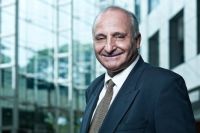The rise of Islamic State in Syria and Iraq, and its impact on European societies, shows how interconnected our world is today. We cannot afford to be ignorant about the Middle East. What happens there has an effect on Europe’s diverse societies, and the same is true for Ireland.
News of a few young men joining Islamic State, or of the arrest of the son of a prominent Dublin imam following a government crackdown on the Muslim Brotherhood in Egypt, show that the current turmoil in the Middle East is also relevant to Ireland.
Islam and Education in Ireland, a recent book by Ali Shehata Abdou Selim, and subsequent public debates, illustrate that Islam is something that has arrived in the midst of Irish society.
Dr Ali Selim, Islamic Cultural Centre of Ireland, Dr Brendan Leahy, Bishop of Limerick, and Rabbi Zalman Lent, leader of the Jewish community of Dublin, at the Three Faiths Forum of Ireland event in the Mansion House last night. Photograph: Dave MeehanMansion House hosts inter-faith forum examining religion’s role in global conflict
An image from Maryam Namazie’s website with a claim that Monday’s speech at Trinity College Dublin on apostasy and the rise of Islam has been “cancelled by organisers”.Activist claims Trinity speech on apostasy and Islam cancelled
Shaykh Umar Al-Qadri from the Al Mustafa Islamic Centre, Dublin. Photograph: Patrick BrowneDublin imam condemns killing and persecution of Christians
The publication of Muslims in Ireland: Past and Present (Edinburgh University Press, 2015), by myself and four colleagues, seeks to provide an in-depth knowledge of our growing Muslim population from a balanced and well-informed academic perspective.
The book is the first complete survey of Muslims in Ireland, including both historical and up-to-date information. It shows that the Irish experience of Muslim immigration and settlement is different from that of other western European countries.
Britain, France and Germany received Muslim immigrants from the 1950s onwards to fill labour shortages in industry. Recruited as unskilled labourers, Muslim immigrants came from socio-economically marginalised backgrounds. They were people who had nothing to lose in their countries of origin and ventured to Europe hoping for better economic prospects.
Their marginalisation often continued as they moved to deprived neighbourhoods of European cities with poor standards of education, healthcare and other facilities.
Different story
Muslim immigration to Ireland since the 1950s has been a completely different story. The majority of Muslim immigrants came as students from privileged backgrounds.
Those who stayed in Ireland worked as professionals and doctors and became part of the Irish middle and upper class. The Muslim “ghettos” of Dublin were Milltown and Clonskeagh, reflecting successful socio-economic integration.
With the arrival of the Celtic Tiger came mass immigration. The Muslim population grew rapidly, from around 4,000 in the early 1990s to an estimated 65,000 now. Mass immigration meant that the profile of the Muslim population changed, from a small middle-class community to a larger grouping marked by social disparities between the more established migrants and the newcomers who came as labourers, asylum seekers and refugees.
Not only is the pattern of Muslim immigration to Ireland different from that in the rest of Europe, but Muslims moved into a society that was, and still is, one of the most religious in Europe.
Catholicism has historically played an important role in defining Irish national identity. Although many Irish Catholics have turned away from the Catholic Church in the past 20 years, church attendance is still high compared to the rest of Europe.
Role of religion
Religion has always played an important public role in Irish society, though this has been contested for some time now. The public expression of one’s religion is not seen as so scandalous or unusual as in some of the more secular societies of western Europe.
Muslims often praise the Irish respect for religion, saying that this makes it easier for them to find understanding for their religious needs. However, the Catholic ethos of Irish society can be a double-edged sword. The Catholic Church’s influence in public life and the Catholic underpinnings of Irish national identity exclude those people, whether Irish citizens or immigrants, who are not Catholic. They are seen as not being properly Irish.
This has been the case with the historical religious minorities in Ireland, Protestants and Jews, and is more true for faith communities that are primarily constituted of immigrants.
Very often, the growing number of Irish converts to Islam are accused by their families and friends of being traitors to the Irish nation because they have embraced another religion.
A campaign of hate letters in 2013, with threatening messages sent to mosques, Islamic organisations and individual Muslims, shows that Ireland is not immune to Islamophobia either.
Muslims in Ireland: Past and Present will be launched in the Long Room Hub at Trinity College Dublin, on Monday, May 11th, at 5.30pm.
Oliver Scharbrodt is professor of Islamic studies at the University of Chester in the UK. For many years, he was based at University College Cork, where he led a pioneering research project on Muslims in Ireland, funded by the Irish Research Council;
Source: The Irish Times





